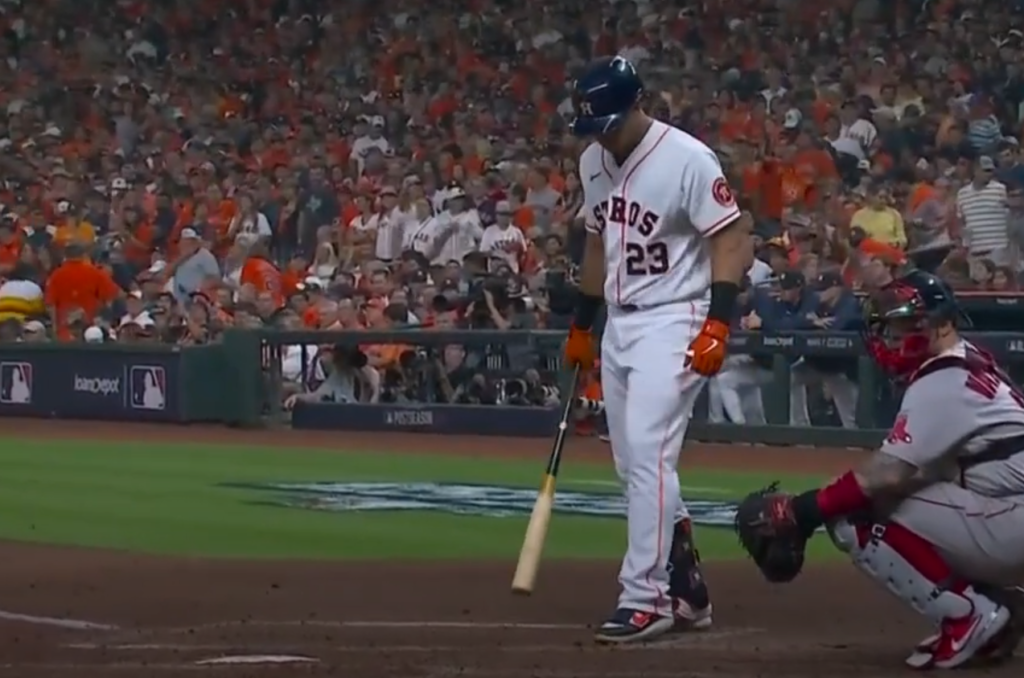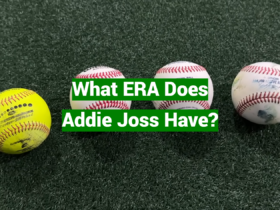In the realm of baseball, Earned Run Average (ERA) stands as a pivotal metric, serving as a barometer for a pitcher’s effectiveness in preventing runs. While a low ERA is universally prized, determining what constitutes a “bad” ERA involves navigating the nuanced landscapes of different baseball levels. This article seeks to unravel the complexities surrounding what is considered a subpar ERA in Major League Baseball (MLB), college baseball, and high school baseball.
Delving into the standards and contextual factors, we aim to shed light on the elusive threshold that distinguishes a mediocre ERA from a truly challenging one in the diverse world of America’s favorite pastime.
Table of Contents
What is ERA?

The ERA formula is relatively straightforward:
- ERA = (EarnedRuns/InningsPitched) ×9
Here, “Earned Runs” refers to the runs scored by the opposing team that can be attributed to the pitcher’s performance. Innings pitched is self-explanatory, representing the total number of innings a pitcher has thrown.
Calculating ERA – A Closer Look
Breaking down the formula, we find that multiplying the earned runs by nine standardizes the metric to a per-nine-innings basis. This normalization allows for easy comparisons between pitchers, irrespective of the total innings they have pitched. As a result, ERA serves as a reliable benchmark for evaluating the effectiveness of pitchers across different games and seasons.
How Is ERA Calculated?
To illustrate the calculation further, consider a pitcher who has given up 10 earned runs in 45 innings. Plugging these values into the ERA formula:
- ERA = (10/45) ×9≈2.00
This pitcher’s ERA is 2.00, indicating that, on average, they allow two earned runs per nine innings pitched. The simplicity of the formula makes ERA a quick and accessible tool for assessing a pitcher’s performance.
Limitations of ERA
While ERA provides valuable insights into a pitcher’s ability to prevent earned runs, it has its limitations. One notable drawback is that it doesn’t account for external factors, such as a team’s defensive prowess or the quality of the opposing hitters. This is where ERA+ comes into play.
Why Is ERA Important In Baseball?
ERA is a key metric for evaluating a pitcher’s individual performance, but it also serves as a defensive metric for the entire team. Teams with lower ERAs are generally better at preventing opponents from scoring, contributing significantly to their overall success [2].
Coaches and managers use ERA to make strategic decisions during games. For example, if a pitcher’s ERA has been consistently rising, it might be an indicator that they need rest or adjustments to their pitching technique. On the other hand, a low ERA may prompt a manager to keep a pitcher in the game, trusting their ability to continue shutting down the opposing team.

ERA+ – Adjusting for External Factors
The formula for ERA+ is:
- ERA+ = (LeagueERA/Pitcher′sERA) ×100
In this formula, a score of 100 represents the league average. A score above 100 indicates a pitcher performed better than the average, while a score below 100 suggests below-average performance.
Real-world Application of ERA+
To understand the practical application of ERA+, let’s consider a hypothetical scenario. Pitcher A and Pitcher B both have an ERA of 3.00, but they play in different leagues with distinct offensive tendencies.
If the league average ERA in Pitcher A’s league is 4.00, and in Pitcher B’s league it’s 2.50, the ERA+ values would be [3]:
- ERA+ (A) = (4.00/3.00)×100 ≈ 133
- ERA+ (B) = (2.50/3.00) ×100 ≈ 83
Despite having the same ERA, Pitcher A has an ERA+ of 133, indicating a performance 33% better than the league average. Conversely, Pitcher B has an ERA+ of 83, suggesting a performance 17% worse than the league average. This showcases the significance of ERA+ in contextualizing a pitcher’s performance within the specific conditions of their league.
Adjusting for Ballpark Effects
Another advantage of ERA+ is its ability to account for the impact of the ballpark. Different stadiums have different dimensions and environmental factors that can influence a pitcher’s performance. ERA+ adjusts for these variations, providing a more accurate reflection of a pitcher’s true ability.

The History of Earned Run Average:
1) The Early Days
The concept of ERA dates back to the late 19th century when baseball statisticians sought a more nuanced measure of a pitcher’s effectiveness. Before ERA, pitchers were primarily assessed by their win-loss records and earned runs allowed. However, this crude approach failed to capture the nuances of a pitcher’s skill.
In 1912, the American League introduced ERA as an official statistic, forever changing the landscape of baseball statistics. The formula was basic but effective: the number of earned runs allowed by a pitcher per nine innings pitched. This innovation marked the beginning of a more sophisticated understanding of pitching performance [4].
2) Adaptations Over Time
As the game advanced, so did the calculations behind ERA. The definition of an “earned run” was refined, and adjustments were made to consider external factors like errors and passed balls. These adjustments aimed to provide a more accurate reflection of a pitcher’s true contribution to preventing runs.
Despite these modifications, ERA remained a relatively simple and widely accepted metric, cementing its place as a cornerstone of baseball analytics.
Different Pitching Stats:
1) FIP – Fielding Independent Pitching
In response to the limitations of ERA, baseball analysts introduced Fielding Independent Pitching (FIP) as an alternative metric. FIP focuses solely on the events a pitcher can control: strikeouts, walks, hit by pitches, and home runs. By excluding factors influenced by team defense, FIP provides a more direct measure of a pitcher’s individual performance.
The formula for FIP is as follows:
- FIP= (13×HR+3×(BB+HBP)−2×K):IP +FIP Constant
FIP has gained traction in recent years as a reliable indicator of a pitcher’s true skill, independent of external factors.
2) xFIP – Expected Fielding Independent Pitching
xFIP takes the principles of FIP a step further by normalizing home run rates. Recognizing that home run rates can fluctuate due to factors beyond a pitcher’s control, xFIP replaces a pitcher’s actual home run total with an expected home run total based on league averages.
The formula for xFIP is [5]:
- xFIP= (13×xHR+3×(BB+HBP)−2×K): IP +FIP Constant
xFIP aims to provide a more stable measure of a pitcher’s true performance by accounting for the variability in home run rates.
Where ERA Falls Short?
Defensive Reliance
One of the primary criticisms of ERA is its reliance on team defense. A pitcher may execute a perfect pitch, only to see a defensive error allow an unearned run. Since ERA encompasses both earned and unearned runs, it fails to fully isolate a pitcher’s individual performance from the defensive capabilities of their team.
This shortcoming becomes particularly evident when comparing pitchers from teams with varying defensive strengths. A pitcher on a team with a stellar defense might have a lower ERA, not necessarily due to their superior skills but because of the support they receive from their teammates.
Ballpark Effects
ERA is also susceptible to the influence of different ballparks. The dimensions, altitude, and environmental conditions of a stadium can impact the number of runs scored, influencing a pitcher’s ERA. While ERA+ attempts to address this by adjusting for league averages, it may still fall short in capturing the intricacies of each ballpark.

Where ERA Succeeds?
Simplicity and Accessibility
Despite its limitations, ERA remains a widely used and easily understandable metric. Its simplicity makes it accessible to fans, players, and analysts alike, contributing to its enduring popularity. While advanced metrics like FIP and xFIP offer more nuanced insights, ERA continues to serve as a valuable tool for quick assessments of a pitcher’s performance.
Historical Context
ERA’s longevity in baseball adds a historical context to the game. The records of legendary pitchers are often discussed in terms of their ERA, creating a bridge between eras and allowing fans to appreciate the evolution of pitching excellence over time. As new metrics emerge, ERA serves as a historical benchmark that enhances our understanding of the sport’s evolution.
What Is Considered a Bad ERA:
The Elite Standard
Major League Baseball sets a high bar for pitching excellence, and as such, the definition of a “bad” ERA is more stringent at this level. In the MLB, an ERA around 4.00 is often considered average, with pitchers aiming to keep their ERAs below this mark to be considered effective [6]. However, what constitutes a “bad” ERA is subjective and can depend on various factors such as the era in which the pitcher is playing, the offensive environment of the league, and the specific team context.
Historical Perspective
In different eras of baseball, the average ERA has fluctuated. During the “Dead Ball Era” in the early 20th century, lower ERAs were more common due to factors such as a lack of home run power. In contrast, the “Steroid Era” saw an increase in offensive production, resulting in higher average ERAs. Understanding the historical context is crucial when assessing whether a pitcher’s ERA is good or bad.
Modern Expectations
Team Context
It’s important to note that a pitcher’s ERA is not solely indicative of their individual performance. Factors such as the quality of the team’s defense, run support, and the pitcher’s home ballpark can influence their ERA. A pitcher with a slightly higher ERA may still be highly effective if they pitch in a hitter-friendly environment and receive minimal run support.
What Is a Bad ERA in College Baseball?
Collegiate Standards
College baseball provides a different context, and what is considered a “bad” ERA is relative to the competition at this level. Unlike the MLB, where pitchers are seasoned professionals, college baseball features a mix of experienced players and emerging talents.
Variation Among Conferences
ERAs in college baseball can vary significantly based on the level of competition within different conferences. In power conferences with strong offenses, a pitcher might have a solid performance with an ERA around 4.00, while the same ERA might be considered subpar in a conference known for stellar pitching and low-scoring games.

Developmental Aspect
College baseball serves as a developmental stage for many players, and the focus is not solely on winning but also on player improvement. As a result, pitchers may be given more leeway in terms of their ERAs as long as they are showing progress and potential for growth.
What Is a Good ERA in High School Baseball?
Foundation for Future Success
High school baseball is where many players begin their journey in organized baseball. Coaches and scouts assess performance differently at this level, considering the developmental aspect and the foundation laid for future success.
High School Standards
In high school baseball, ERAs can vary widely due to factors such as the skill level of opponents, the quality of coaching, and the overall competitiveness of the league. An ERA below 3.00 is generally considered impressive at the high school level, and pitchers with ERAs in the 2.00 or lower range are often seen as standouts [7].
Balancing Expectations
While performance is crucial, high school coaches often prioritize player development over strict adherence to win-loss records and ERAs. Pitchers may be given opportunities to refine their skills and learn from their experiences, even if their ERAs are not as low as those of more seasoned players.

Is a High ERA Good or Bad in Baseball:
Why a Low ERA is Better Than a High ERA in Baseball?
1. Pitchers With a Low ERA Are More Effective at Preventing Runs
At its core, ERA measures a pitcher’s ability to prevent runs. A low ERA indicates that a pitcher is successful in limiting the number of earned runs scored by the opposing team. In contrast, a high ERA suggests that a pitcher is more susceptible to giving up runs, which can have a detrimental impact on the team’s chances of winning.
Consider two pitchers: Pitcher A with a 2.50 ERA and Pitcher B with a 5.00 ERA. On average, Pitcher A allows fewer earned runs per nine innings pitched compared to Pitcher B. Teams typically prioritize pitchers with low ERAs as they contribute significantly to the team’s defensive strength.
2. Pitchers With a High ERA Give Up More Runs on Average
Beyond the numerical representation, the essence of ERA lies in its reflection of a pitcher’s contribution to the team’s success. A high ERA suggests that a pitcher is less effective at preventing opponents from scoring, leading to a higher average number of runs allowed [8].
In a sport where the margin of victory can be slim, every run matters. A pitcher with a low ERA not only contributes to the team’s defensive prowess but also provides a buffer, reducing the burden on the offense to compensate for a high number of runs conceded.
3. High ERA Pitchers Allow More Base Runners
ERA is not solely about earned runs; it also indirectly reflects a pitcher’s ability to control the base paths. A high ERA often correlates with a higher number of base runners allowed, indicating that the pitcher struggles to keep opposing batters off the bases.
Pitchers with low ERAs are typically more adept at limiting walks, hits, and hit-by-pitches, thereby minimizing the opportunities for the opposing team to score. By maintaining better control over the base runners, these pitchers exert greater influence over the flow of the game.

4. Team Confidence and Momentum
A pitcher with a low ERA can boost team confidence and momentum. Knowing that their pitcher is reliable and capable of keeping the opposition’s scoring in check gives the team a psychological advantage [9]. It allows batters to approach their at-bats with the confidence that their efforts will not be undermined by a large deficit created by the opposing team’s offense.
On the contrary, a high ERA can have a demoralizing effect on a team. It may create a sense of pressure on the offense to score more runs, leading to a heightened risk of strategic errors and an overall decline in team morale.
FAQ:
1. Is a 7.00 ERA good?
No, a 7.00 ERA is generally considered high in baseball. It indicates that, on average, the pitcher allows seven earned runs per nine innings pitched. Pitchers strive for lower ERAs to be more effective in preventing runs.
2. Is an ERA of 1 good?
Yes, an ERA of 1 is exceptional in baseball. A pitcher with an ERA of 1 is highly effective in limiting earned runs, showcasing an elite level of performance and run prevention.
3. Is a lower ERA better in baseball?
Yes, a lower ERA is better in baseball. It signifies that a pitcher is more successful in preventing earned runs, contributing to the team’s defensive strength.
4. What is a 0.00 ERA?
A 0.00 ERA indicates that the pitcher has not allowed any earned runs during the specified innings pitched. It reflects a perfect run prevention record.
5. Is a 4.5 ERA good?
A 4.5 ERA is considered average in baseball. While it may vary based on the league’s offensive environment, pitchers generally aim for ERAs below 4.00 to be considered effective.
6. What is a good career ERA in baseball?
A good career ERA in baseball can vary, but pitchers with career ERAs below 3.50 are often considered excellent. Hall of Fame pitchers typically boast even lower career ERAs.
7. Is a 2.5 ERA good?
Yes, a 2.5 ERA is excellent in baseball. It indicates that the pitcher allows, on average, 2.5 earned runs per nine innings pitched, showcasing a high level of run prevention.
8. Is a low ERA in baseball good?
Yes, a low ERA in baseball is considered good. Pitchers aim to maintain low ERAs to be effective in preventing runs and contributing to the team’s success.
9. What is the lowest ERA in MLB history?
As of my knowledge cutoff in 2022, Dutch Leonard holds the record for the lowest single-season ERA in MLB history with a remarkable 0.96 in 1914.
10. Why is ERA per 9 innings?
ERA is calculated per 9 innings to standardize the metric for easy comparison across different pitchers and games. This normalization allows a fair assessment of pitchers regardless of the total innings they have pitched.
11. Who has the best ERA ever?
Dutch Leonard, with a single-season ERA of 0.96 in 1914, is often considered to have the best ERA in a single season in MLB history.
12. Who has the lowest lifetime ERA?
Ed Walsh holds the record for the lowest career ERA in MLB history, with a remarkable 1.82 over 1,990 innings pitched from 1904 to 1917.
13. Is a 1.8 ERA good?
Yes, a 1.8 ERA is exceptional in baseball. It signifies a pitcher’s ability to prevent earned runs at an elite level.
14. Is a 2.95 ERA good?
Yes, a 2.95 ERA is considered good in baseball. It indicates effective run prevention, and pitchers with such ERAs are generally seen as reliable.
15. Is a 3.00 ERA good?
Yes, a 3.00 ERA is considered good in baseball. It represents solid pitching performance and effective run prevention.
16. Is a 6.00 ERA good?
No, a 6.00 ERA is generally considered high in baseball. It suggests a higher-than-average rate of earned runs allowed per nine innings pitched.
17. Is a 3.32 ERA good?
Yes, a 3.32 ERA is considered good in baseball. It indicates effective pitching and a relatively low rate of earned runs allowed.
18. How do you calculate ERA?
ERA is calculated by dividing the total earned runs allowed by a pitcher by the total innings pitched, then multiplying by 9. The formula is: \[ ERA = \frac{Earned Runs}{Innings Pitched} \times 9 \]
19. Is 3.50 a good ERA?
Yes, a 3.50 ERA is generally considered good in baseball. It indicates effective run prevention and solid pitching performance.
20. Is a 3.24 ERA good?
Yes, a 3.24 ERA is considered good in baseball. It reflects effective pitching with a relatively low rate of earned runs allowed.
21. Is 4.5 a good ERA?
A 4.5 ERA is generally considered average in baseball. Pitchers often aim for lower ERAs to be more effective in preventing runs.
22. Can you have a 0 ERA?
While extremely rare, a pitcher can have a 0.00 ERA if they have not allowed any earned runs in the innings they’ve pitched. It signifies perfect run prevention.
23. Is ERA calculated per game or inning?
ERA is calculated per inning. It represents the average number of earned runs a pitcher allows per nine innings pitched, standardizing the metric for easy comparison.
24. What is K-9 in baseball?
K-9, or strikeouts per nine innings, is a statistic that measures a pitcher’s average number of strikeouts per nine innings pitched. It provides insights into a pitcher’s ability to record strikeouts.
25. What’s the worst MLB record ever?
The 1962 New York Mets hold the record for the worst MLB record in a single season with a 40-120 win-loss record.
26. Who had a 1.12 ERA?
In 1968, Bob Gibson had a remarkable 1.12 ERA for the St. Louis Cardinals, considered one of the greatest pitching performances in MLB history.
27. Is Higher ERA+ better?
No, a higher ERA+ is not better. ERA+ is adjusted for external factors and normalized to the league average. A score of 100 is considered average, and scores above 100 indicate performance better than the league average.
28. What is the best ERA+ ever?
Pedro Martinez holds the record for the highest single-season ERA+ with a remarkable score of 291 in 2000.
29. Has there ever been a 2-pitch inning?
Yes, there have been instances of a 2-pitch inning in baseball, where a pitcher records three outs with only two pitches. It’s a rare and efficient feat in the game.
Useful Video: PITCHING STATISTICS, ERA, FIP, WHIP, ERA+ – Baseball Basics
References:
- http://www.lootmeister.com/mlb/good-bad-era.php
- https://baseballtrainingworld.com/is-high-era-good-or-bad-in-baseball/
- https://www.mlb.com/glossary/standard-stats/earned-run-average
- https://www.predictem.com/mlb/baseball-betting-era-earned-run-average/
- https://thedatajocks.com/what-is-era-in-baseball/
- https://coachingkidz.com/what-is-era-in-baseball-a-complete-guide-to-the-statistic/
- https://www.sportslingo.com/sports-glossary/e/earned-run-average-era/
- https://www.suzitee.com/blogs/baseball/what-is-era-in-baseball-a-comprehensive-guide
- https://honestbaseball.com/what-is-a-good-era/






Leave a Reply